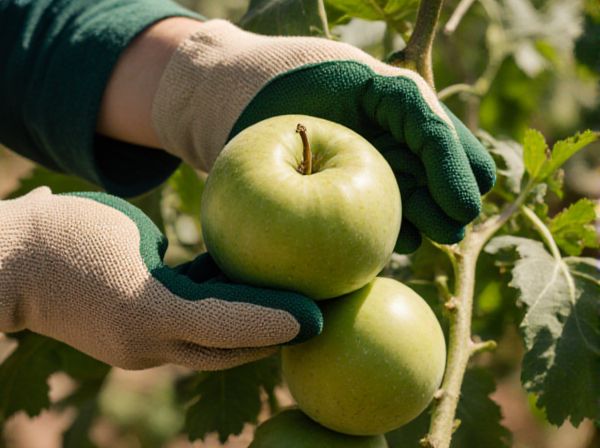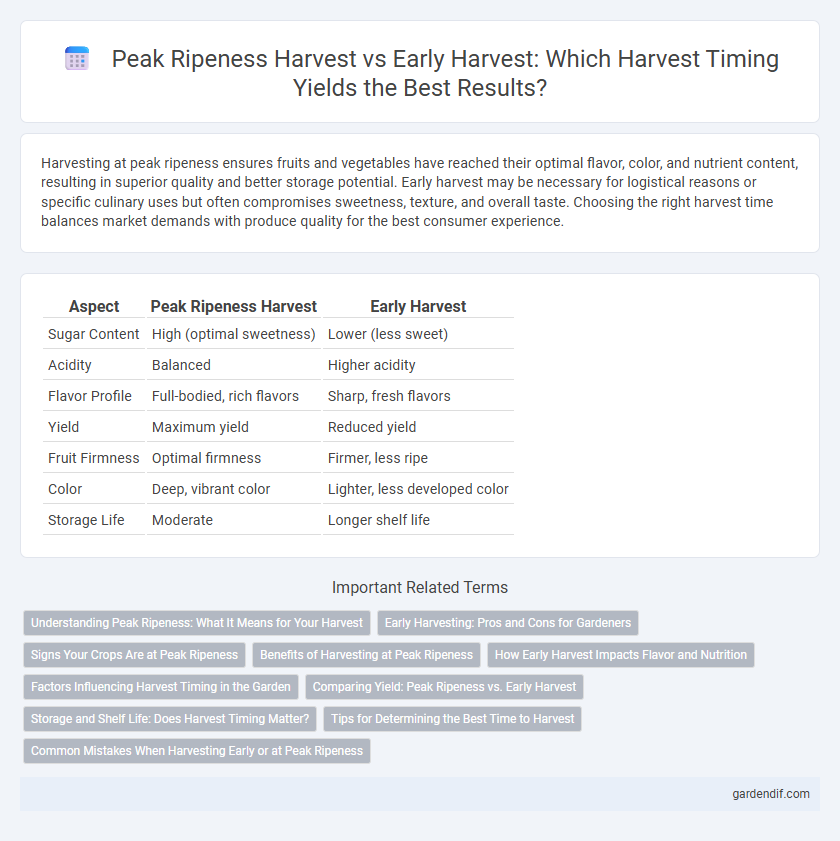
Peak Ripeness Harvest vs Early Harvest Illustration
Harvesting at peak ripeness ensures fruits and vegetables have reached their optimal flavor, color, and nutrient content, resulting in superior quality and better storage potential. Early harvest may be necessary for logistical reasons or specific culinary uses but often compromises sweetness, texture, and overall taste. Choosing the right harvest time balances market demands with produce quality for the best consumer experience.
Table of Comparison
| Aspect | Peak Ripeness Harvest | Early Harvest |
|---|---|---|
| Sugar Content | High (optimal sweetness) | Lower (less sweet) |
| Acidity | Balanced | Higher acidity |
| Flavor Profile | Full-bodied, rich flavors | Sharp, fresh flavors |
| Yield | Maximum yield | Reduced yield |
| Fruit Firmness | Optimal firmness | Firmer, less ripe |
| Color | Deep, vibrant color | Lighter, less developed color |
| Storage Life | Moderate | Longer shelf life |
Understanding Peak Ripeness: What It Means for Your Harvest
Peak ripeness harvest ensures optimal sugar content, flavor complexity, and balanced acidity, resulting in superior fruit quality and enhanced wine character. Early harvest often leads to higher acidity and lower sugar levels, which can be beneficial for producing fresher, lighter wines but may lack depth. Understanding peak ripeness involves monitoring color, firmness, and Brix levels to achieve the ideal balance for the desired end product.
Early Harvesting: Pros and Cons for Gardeners
Early harvesting allows gardeners to enjoy fruits and vegetables sooner, ensuring fresh produce ahead of peak ripeness. It reduces the risk of damage from pests, diseases, and adverse weather conditions that often increase as crops near full maturity. However, early harvest can result in lower sugar content and reduced flavor intensity compared to peak ripeness, potentially impacting overall yield quality.
Signs Your Crops Are at Peak Ripeness
Signs your crops are at peak ripeness include vibrant color development, firm texture, and a characteristic aroma specific to each fruit or vegetable. Measuring sugar content using a refractometer and observing seed maturity are reliable indicators for optimal harvest timing. Early harvest may result in reduced flavor and nutrient density, while peak ripeness ensures maximum yield quality and market value.
Benefits of Harvesting at Peak Ripeness
Harvesting at peak ripeness maximizes sugar content, flavor complexity, and nutrient density, ensuring superior quality produce ideal for fresh consumption or processing. This timing enhances the development of antioxidants and vitamins, which contribute to both taste and health benefits. In contrast to early harvest, peak ripeness reduces post-harvest deterioration and improves shelf life, benefiting both producers and consumers.
How Early Harvest Impacts Flavor and Nutrition
Harvesting grapes early enhances acidity and preserves higher levels of vitamin C, resulting in a fresher, more vibrant flavor profile compared to peak ripeness harvest. Early harvest wines often exhibit sharper, more pronounced fruit notes and lower sugar content, which can lead to lower alcohol levels and a lighter body. Nutritionally, the retention of antioxidants and phenolic compounds is greater in early harvested fruits, contributing to improved health benefits.
Factors Influencing Harvest Timing in the Garden
Harvest timing in the garden is influenced by factors such as fruit sugar content, acidity levels, and color development, which determine peak ripeness. Weather conditions, including temperature and rainfall, also play a critical role in deciding between early harvest and peak ripeness harvest. Additionally, the intended use of the produce, whether for immediate consumption or storage, impacts the choice of harvest time.
Comparing Yield: Peak Ripeness vs. Early Harvest
Peak ripeness harvest typically results in higher yields due to fully developed fruit size and sugar content, maximizing juice volume and flavor concentration. Early harvest offers lower yields with smaller fruit size but can enhance acidity and freshness, appealing to specific wine profiles or storage needs. Comparing yield, peak ripeness maximizes quantity and quality balance, while early harvest prioritizes acidity over volume.
Storage and Shelf Life: Does Harvest Timing Matter?
Harvest timing significantly impacts storage and shelf life, with peak ripeness harvests offering optimal flavor but shorter shelf life due to higher sugar and moisture content. Early harvest fruits often have firmer texture and lower sugar levels, enhancing storage durability and prolonging shelf life under controlled conditions. Selecting the appropriate harvest window ensures balance between immediate quality and extended preservation for market demands.
Tips for Determining the Best Time to Harvest
To determine the best time for peak ripeness harvest, monitor fruit color changes, texture firmness, and sugar content using a refractometer for accurate Brix levels. Early harvest may be necessary to avoid weather damage, but it often results in lower flavor intensity and reduced nutrient content compared to fruits picked at full maturity. Conduct taste tests and observe seed development stages to ensure optimal flavor and storage life for crops like grapes, apples, and tomatoes.
Common Mistakes When Harvesting Early or at Peak Ripeness
Harvesting at peak ripeness ensures maximum sugar content and flavor development while early harvest often results in underdeveloped aromas and higher acidity. Common mistakes include misjudging fruit maturity leading to poor quality and inconsistent fermentation outcomes. Ignoring weather conditions and delaying harvest beyond peak ripeness increases the risk of overripeness, spoilage, and reduced shelf life.
Peak Ripeness Harvest vs Early Harvest Infographic

 gardendif.com
gardendif.com